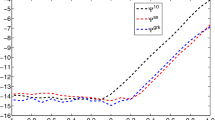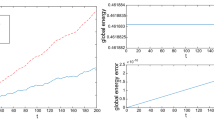Abstract
We consider the application of partitioned Runge-Kutta (PRK) methods to non-autonomous Hamiltonian systems. Necessary and sufficient conditions for the symplecticness of PRK methods are given, more particularly for two low order PRK methods: the partitioned (explicit-implicit) Euler method and the 2-stage Lobatto IIIA-B PRK method. Both methods are often the basis of composition schemes of higher order. In particular for irreducible PRK methods we show the necessity for the nodes of the two underlying PRK methods to be equal.


Similar content being viewed by others
References
Abia, L., Sanz-Serna, J.M.: Partitioned Runge-Kutta methods for separable Hamiltonian problems. Math. Comput. 60, 614–634 (1993)
Bader, P., Blanes, S., Casas, F., Kopylov, N., Ponsada, E.: Symplectic integrators for second-order linear non-autonomous equations. J. Comput. Appl. Math. 330, 909–919 (2018)
Blanes, S., Casas, F.: Splitting methods for non-autonomous separable dynamical systems. J. Phys. A: Math. Gen. 39, 5405–5423 (2006)
Blanes, S., Casas, F.: A concise introduction to geometric numerical integration. Monographs and Research Notes in Mathematics Chapman and Hall/CRC (2016)
Blanes, S., Moan, P.: Splitting methods for non-autonomous Hamiltonian equations. J. Comput. Phys. 170, 205–230 (2001)
Cano, B., Lewis, H.: A comparison of symplectic and Hamilton’s principle algorithms for autonomous and non-autonomous systems of ordinary differential equations. Appl. Num. Math. 39, 289–306 (2001)
Diele, F., Marangi, C.: Explicit symplectic partitioned Runge-Kutta Nyström methods for non-autonomous dynamics. Appl. Num. Math. 61, 832–843 (2011)
Hairer, E.: Backward analysis of numerical integrators and symplectic methods. Annals Numer. Math. 1, 107–132 (1994)
Hairer, E., Lubich, C., Wanner, G.: Geometric Numerical Integration., Comput Math., 2nd edn., vol. 31. Springer, Berlin (2006)
Hairer, E., Wanner, G.: Solving Ordinary Differential Equations II. Stiff and Differential-Algebraic Problems, Comput Math., 2nd edn., vol. 14. Springer, Berlin (1996)
Marthinsen, H., Owren, B.: Geometric integration of non-autonomous linear Hamiltonian problems. Adv. Comput. Math. 42, 313–332 (2016)
Sanz-Serna, J.M.: Geometric integration. In: Duff, I.S., Watson, G.A. (eds.) The State of the Art in Numerical Analysis (York, 1996), Inst. Math. Appl. Conf. Ser. New Ser. Oxford University Press, Clarendon, vol. 63, pp 121–143 (1997)
Sanz-Serna, J.M.: Symplectic Runge–Kutta schemes for adjoint equations, automatic differentiation, optimal control, and more. SIAM Rev. 58, 3–33 (2016)
Sanz-Serna, J.M., Calvo, M.P.: Numerical Hamiltonian Problems, Appl. Math. and Math Comput., vol. 7. Chapman & Hall, London (1994)
Acknowledgements
The author would like to thank the anonymous referees for their constructive criticisms which helped improve the clarity of the paper.
Author information
Authors and Affiliations
Corresponding author
Additional information
Publisher’s note
Springer Nature remains neutral with regard to jurisdictional claims in published maps and institutional affiliations.
Appendix: Main lines of a proof of Theorem 2.2
Appendix: Main lines of a proof of Theorem 2.2
To prove the necessity of conditions (2.4b) we have assumed that the PRK method is irreducible in the sense given in [9, VI.7] and [9, Theorem VI.7.10, p. 222]. A reducible PRK method is defined as a method having equivalent stages (Qi = Qj and Pi = Pj for i≠j). We have also added the condition (2.8), i.e., that no index i exists where bi = 0 and \({\widehat {b}_{i}}=0\). This eliminates methods having stages that have no influence on the numerical solution q1, p1 similar to the DJ-irreducibility of RK methods [10, Definition 12.15]. This is justified as follows. We already know that the conditions (2.4a), and (2.4c) are necessary for symplecticness. Assuming that there is an index i such that bi = 0 or \({\widehat {b}_{i}}=0\), supposed to be unique for now, from the necessary conditions (2.4a) and (2.4c) we then obtain \({\widehat {b}_{i}}=0\), bi = 0, aji = 0, and \({\widehat {a}_{ji}}=0\) for j ∈{1, … , s}∖{i}. Hence, clearly in this situation the internal stages Qi, Pi will not influence the solution q1, p1 and the other internal stages Qj, Pj for j≠i. If there is more than one index i with bi = 0 and \({\widehat {b}_{i}}=0\), then one can easily show that all those internal stages can only influence each other, but they can influence neither the solution q1, p1, nor the other internal stages Qj, Pj with coefficients \(b_{j}={\widehat {b}}_{j}\not =0\). With that additional assumption (2.8) one is then in position to prove the necessity of (2.4b).
Proof
We can extend the sets of trees considered in [9, VI.7] and [9, Theorem VI.7.10, p. 222] by having an extra type of nodes, say grey nodes, standing for the value 1 of the scalar differential equation \(\dot {t}=1\). We use the notation and definitions given in [9] though we exchange the role of q and p and f and g. No node is attached on top of a grey node since the partial derivatives of a constant vanish. A branch leading to a grey node stands for a partial differentiation with respect to t. For the order conditions of partitioned methods, grey nodes need not be indexed. When a grey node follows a black node with index j, then the sum in the order conditions over the index j = 1, … , s must contain the coefficients cj. When a grey node follows a white node with index j, then the sum in the order conditions over the index j = 1, … , s must contain the coefficients \({\widehat {c}_{j}}\). Consider a P-series with coefficients a(u)
For a P-series to be symplectic one of the necessary conditions for autonomous Hamiltonian systems is to have
The same necessary condition holds for non-autonomous Hamiltonian systems for trees also containing grey nodes. This can be easily shown on a similar example given in the proof of [9, Theorem VI.7.4, p. 217] where the top black node of the tree u is replaced by a grey node. For that tree we take
and for that Hamiltonian we get
where \({\bar u}\) is the tree obtained from u by replacing its black root with a white root. These elementary differentials are the only contribution to
and we get
Now to prove our statement we can consider the same PRK matrix ΦPRK as given in [9, VI.7] and [9, Theorem VI.7.10, p. 222], we do not even need to consider trees with grey nodes in that matrix. We define the vector \(d\in {\mathbb {R}}^{s}\) with elements \(d_{i}:=b_{i}c_{i}-{\widehat {b}}_{i}{\widehat {c}}_{i}\) for i = 1, … , s. For irreducible PRK methods we already know that the condition \({\widehat {b}}_{i}=b_{i}\) for i = 1, … , s is necessary for symplecticness, hence we obtain \(d_{i}=b_{i}(c_{i}-{\widehat {c}}_{i})\) for i = 1, … , s. The vector d satisfies
since \(d^{T}\phi (u)=a(v)-a({\bar v})\) where v is obtained from u by appending a grey node to its root and \(a(v)=a({\bar v})\) for v ∈ TPq as seen above. Since the matrix ΦPRK is of maximal rank s we must have d = 0, hence its components satisfy \(d_{i}=b_{i}(c_{i}-{\widehat {c}}_{i})=0\) for i = 1, … , s. Since bi ≠ 0 for i = 1, … , s we obtain (2.4b). □
Rights and permissions
About this article
Cite this article
Jay, L.O. Symplecticness conditions of some low order partitioned methods for non-autonomous Hamiltonian systems. Numer Algor 86, 495–514 (2021). https://doi.org/10.1007/s11075-020-00898-6
Received:
Accepted:
Published:
Issue Date:
DOI: https://doi.org/10.1007/s11075-020-00898-6




